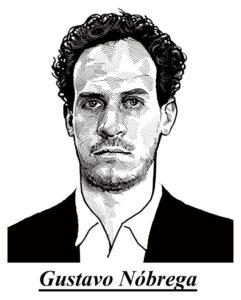Still under 40, discreet and ceremonious, Gustavo Nóbrega is the antithesis of a salesman or a Larry Gagosian.
The Superfície Gallery – which he opened 10 years ago in a 45m² space on Oscar Freire Street – reflects the story of its creator: an artist turned gallerist, which led him to structure the business in a unique way.

His grandfather opened a gallery – Nóbrega Antiguidade e Galeria de Arte – back in 1935, and the boy grew up in the business. His father inherited the gallery and ran the business while maintaining an artistic production.
The studio/gallery routine was the cornerstone of his education and professional training, which makes Gustavo one of the most interesting gallerists of his generation.
In addition to managing the programming, representation of artists and sales, Gustavo dedicates time to setting up the Superfície Archive, focused on research and digitization of documents related to conceptual and avant-garde art, and Superfície Publications, which edits unique and historical projects in a superb way.
Even when sending invitations to vernissages, paper is valued. While most galleries send an email, at Superfície the invitation goes by mail – with special paper and elaborate design.
Gustavo the gallerist started after 7 years of Gustavo the artist, who exhibited outside Brazil and has a work at the Pinacoteca. It was a way to reinforce revenue, but gradually Gustavo stopped producing to become a full-time gallerist.
“I had just returned from a residency in New York and saw that there were several galleries in small spaces there. I realized that square footage didn’t matter, nor did the number of partners. I decided to specialize in works on paper and the program naturally began to focus on artists who used words in images, like Leonilson and Mira Schendel,” Gustavo told Brazil Journal.
Those looking for artwork to match their sofa do not look to Superfície, whose programming attracts a sophisticated audience of intellectuals and artists. Most of their sales are to institutions – national and international – and major collectors focused on this more “heady” and less commercial art.
“I started the gallery already thinking about working with primary and secondary markets and with this specific type of art. Gradually, some young artists, who also used words or were more politically engaged, began to approach. I ended up with Poema Processo, which is this movement of visual poetry from the 60s and led me to conceptual art.”
Gustavo says that the gallery’s choice of representation goes through artists who have a connection to poetry or political or conceptual engagement. The concern is with the art, not the commercial potential.
“I wanted to bring back artists who were important but were forgotten because the art world didn’t absorb their production, or because the artist died young or sometimes because the artist himself became frustrated with the market and withdrew. Many were anti-market and anti-museum. That is why they need a review and recognition – people who in the 60s and 70s had extreme importance in art history and almost no one remembers.”
The good news for those who fear that the audience for this type of art is becoming extinct is that the gallery is in its prime, and now, at 10 years old, has just opened a new space in Jardins, at Casa 4 of the Modernist Village of Flávio de Carvalho, a few meters from the original address.
Superfície Vila Modernista will have a special exhibition program parallel to the original headquarters on Oscar Freire Street.
Superfície “is the most important young gallery in São Paulo,” Luisa Strina told me. “It’s been 10 years of research (which few do today) and serious and consistent work.”
To inaugurate the new space, Gustavo organized an exhibition titled Jornais e Etc.
It took almost 8 years to map artists who use newspapers as support. The collective brings the newspaper as the protagonist of the art scene from the 60s to today, bringing together 21 names such as Antonio Manuel, Amélia Toledo and Paulo Bruscky, and younger artists like Cinthia Marcelle, Renata Lucas and André Komatsu.
Gustavo says he doesn’t remember an exhibition that has addressed the theme in this way in the country – which is somewhat curious because many artists have used newspapers as a theme at some point in their careers.
This relationship has yielded famous works, such as Dali News, in which the Spanish surrealist painter created an absurd newspaper about himself, to Picasso, who in 1912 innovated by using a page from a Parisian newspaper for a collage called Violão, Partitura e Vidro.
Luis Buñuel said that when he died he would like to come back to life just to be able to buy newspapers.
Even in the digital age, and despite the influencers who steal our attention, the fascination and interest in newspapers remain alive. The good old newspaper – as curator of an increasingly complex reality, and filter of what is fake and what is fact – is still a pillar of civilized society. And precisely for this reason, we need them more and more, in art and in life.
The exhibition is on display until October 12th.
Source
Arwen Volkov, A graduate of the University of St. Gallen in Switzerland with a degree in International Finance, Arwen specializes in sustainable finance and green investments. She began her career at an investment bank in London, where she developed financing models for environmentally friendly projects. Known for her analytical and strategic thinking skills, Arwen is a sought-after financial consultant. In her spare time, she mentors fintech startups, contributing to their growth strategies. She is also a nature enthusiast and an amateur photographer.
